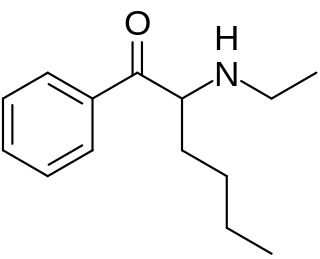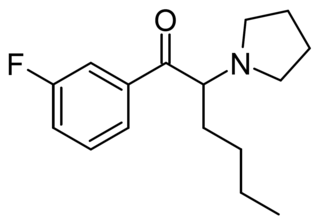A designer drug is a structural or functional analog of a controlled substance that has been designed to mimic the pharmacological effects of the original drug, while avoiding classification as illegal and/or detection in standard drug tests. Designer drugs include psychoactive substances that have been designated by the European Union, Australia, and New Zealand, as new psychoactive substances (NPS) as well as analogs of performance-enhancing drugs such as designer steroids.

Methylenedioxypyrovalerone is a stimulant of the cathinone class that acts as a norepinephrine–dopamine reuptake inhibitor (NDRI). It was first developed in the 1960s by a team at Boehringer Ingelheim. Its activity at the dopamine transporter is six times stronger than at the norepinephrine transporter and it is virtually inactive at the serotonin transporter. MDPV remained an obscure stimulant until around 2004 when it was reportedly sold as a designer drug. In the US, products containing MDPV and labeled as bath salts were sold as recreational drugs in gas stations, similar to the marketing for Spice and K2 as incense, until it was banned in 2011.

Substituted phenethylamines are a chemical class of organic compounds that are based upon the phenethylamine structure; the class is composed of all the derivative compounds of phenethylamine which can be formed by replacing, or substituting, one or more hydrogen atoms in the phenethylamine core structure with substituents. Phenylethylamines are also generally found to be central nervous system stimulants with many also being entactogens/empathogens, and hallucinogens.

α-Pyrrolidinopentiophenone (α-PVP), also known as α-pyrrolidinovalerophenone, O-2387, β-keto-prolintane, prolintanone, or desmethylpyrovalerone, is a synthetic stimulant of the cathinone class developed in the 1960s that has been sold as a designer drug and often consumed for recreational reasons. α-PVP is chemically related to pyrovalerone and is the ketone analog of prolintane.

Substituted cathinones, or simply cathinones, which include some stimulants and entactogens, are derivatives of cathinone. They feature a phenethylamine core with an alkyl group attached to the alpha carbon, and a ketone group attached to the beta carbon, along with additional substitutions. Cathinone occurs naturally in the plant khat whose leaves are chewed as a recreational drug.

Eutylone is a stimulant and empathogenic drug of the phenethylamine, amphetamine, phenylisobutylamine, and cathinone families which was developed in the 1960s, which is classified as a designer drug. It was first reported to the EMCDDA in 2014 and became widespread internationally in 2019-2020 following bans on the related compound ephylone. It is a synthetic cathinone. In 2021, eutylone was the most common cathinone identified by the Drug Enforcement Administration in the United States.

3,4-Methylenedioxycathinone is an empathogen and stimulant of the phenethylamine, amphetamine, and cathinone classes and the β-keto analogue of MDA.

Pentedrone is a stimulant of the cathinone class that has been sold as a designer drug and has been found since 2010 as an ingredient in a number of "bath salt" mixes sold as legal highs.

Bath salts are a group of recreational designer drugs. The name derives from instances in which the drugs were disguised as bath salts. The white powder, granules, or crystals often resemble Epsom salts, but differ chemically. The drugs' packaging often states "not for human consumption" in an attempt to circumvent drug prohibition laws. Additionally, they may be described as "plant food", "powdered cleaner", or other products.

α-Pyrrolidinohexiophenone is a synthetic stimulant drug of the cathinone class developed in the 1960s which has been reported as a novel designer drug.

5-DBFPV is a stimulant of the cathinone class that has been sold online as a designer drug. It is an analogue of MDPV where the methylenedioxyphenyl group has been replaced by dihydrobenzofuran.

N-Ethylhexedrone (also known as α-ethylaminocaprophenone, N-ethylnorhexedrone, hexen, and NEH) is a stimulant of the cathinone class that acts as a norepinephrine–dopamine reuptake inhibitor (NDRI) with IC50 values of 0.0978 and 0.0467 μM, respectively. N-Ethylhexedrone was first mentioned in a series of patents by Boehringer Ingelheim in the 1960s which led to the development of the better-known drug methylenedioxypyrovalerone (MDPV). Since the mid-2010s, N-ethylhexedrone has been sold online as a designer drug. In 2018, N-ethylhexedrone was the second most common drug of the cathinone class to be identified in Drug Enforcement Administration seizures.

MDPHP (3',4'-Methylenedioxy-α-pyrrolidinohexiophenone) is a stimulant of the cathinone class originally developed in the 1960s, which has been reported as a novel designer drug. In the UK its slang name is monkey dust. It is closely related to the potent stimulant MDPV though with slightly milder effects, and has been used as an alternative in some countries following the banning of MDPV.

N,N-Dimethylpentylone is a substituted cathinone derivative with stimulant effects, which has been sold as a designer drug, first detected in Sweden in 2014.

N-Ethylhexylone is a recreational designer drug from the substituted cathinone family, with stimulant effects. It was first identified in Poland in August 2019. It is illegal in Taiwan since July 2020, where it had been sold mixed with plant material under the name 彩虹菸.

MFPVP (3-Methyl-4-fluoro-α-pyrrolidinovalerophenone) is a recreational designer drug from the substituted cathinone family, with stimulant effects. It was first identified in Sweden in April 2020 and was among the most widely encountered substituted cathinone derivatives in 2021, though it since appears to have declined in prevalence. It is illegal in Virginia.

3-Fluoro-N-ethylbuphedrone (3F-NEB) is a substituted cathinone derivative with stimulant effects which has been sold as a designer drug. It was first identified in Sweden in 2021.

2-Methyl-alpha-PVP (2-Me-PVP) is a substituted cathinone derivative with stimulant effects which has been sold as a designer drug. It was first identified in Sweden in 2021.

3-Fluoro-alpha-PHP (3F-PHP) is a substituted cathinone derivative with stimulant effects which has been sold as a designer drug. It was first identified in Sweden in 2020 and continues to be detected in seized drug samples, though it appears to have been less widely used than related compounds such as 3F-PVP and 3F-PiHP.

4-Fluoroephedrine (4-FEP) is a "novel psychoactive substance" and substituted β-hydroxyamphetamine derivative related to ephedrine.



















